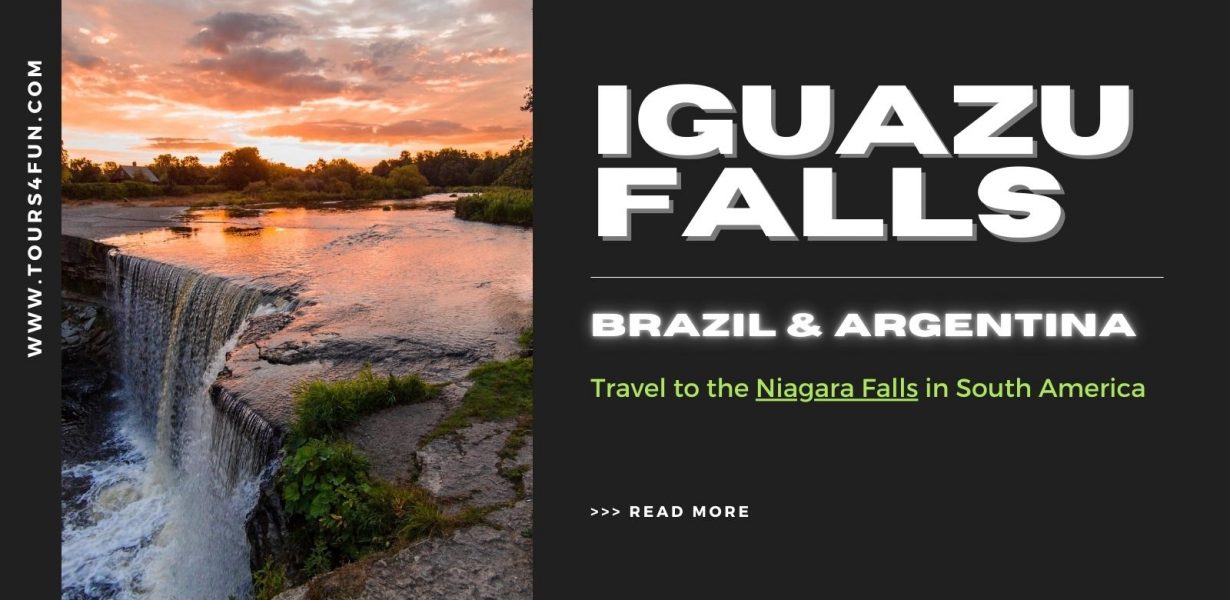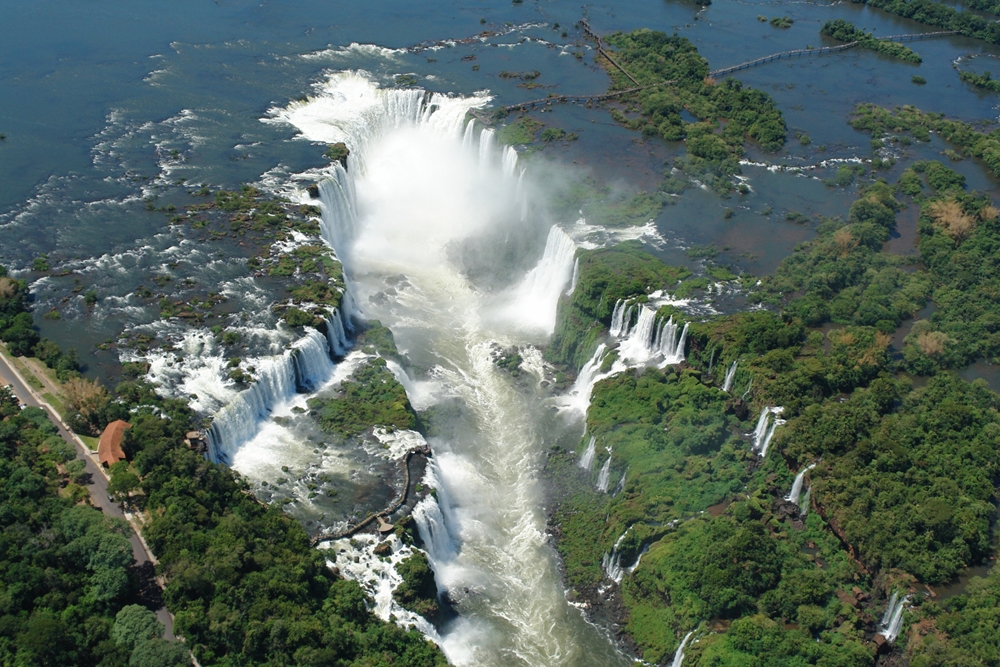When you travel to South America, you expect to be wowed, surprised, and even flabbergasted, whether it be from culture shock, the change in climate, or the sheer variety of landscapes. What you don’t expect to find something familiar, a site that mirrors a great wonder of North America.
For many, Niagara Falls is the ultimate waterfall, a romantic experience like no other. But for South America, Iguazu Falls, the world’s largest waterfall system, overshadows its twin to the north, mixing the majesty of Niagara Falls with the beauty of the South American jungles.
Where is Iguazu Falls Located?
Much like the romantic Niagara Falls, the Iguazu Falls is split between Brazil and Argentina, together creating a spectacle of thunderous white waves crashing over green cliffs. This divide runs through the Devil’s Throat where the Iguazu River converges, with the majority of the falls resting on the Argentinian side.
The falls are part of two national parks: Iguaçu National Park in Brazil and Iguazú National Park in Argentina. Together, these parks encompass approximately 670 square kilometers (259 square miles) of lush subtropical rainforest, recognized as a UNESCO World Heritage site.
From Brazil: The Brazilian side of the falls is closest to the city of Foz do Iguaçu in the state of Paraná. This city is well-connected to other major cities in Brazil by air and road, with Foz do Iguaçu International Airport (IGU) serving as the main gateway for visitors.
From Argentina: On the Argentine side, the nearest town is Puerto Iguazú, located in the province of Misiones. Puerto Iguazú is accessible via Cataratas del Iguazú International Airport (IGR), which receives direct flights from Buenos Aires and other key cities in Argentina.
Book guided IGUAZU FALLS TOURS from Brazil or Argentina
✨To enjoy the full glory of the falls, a tour of both Brazil and Argentina side is recommended.
Iguazu Falls: Brazil Side vs. Argentina Side
Since 1876 efforts have been made to protect the falls and surrounding wildlife, and both the Brazilian and Argentinian government have worked tirelessly to preserve the nature beauty of the region while allowing anyone to see the glory of the falls. As a result, each side offers a variety of trails to see the cascading falls up close and personal.
Here’s a detailed comparison between Iguazu falls Brazil side and Argentina side:
| Feature | Brazil Side (Parque Nacional do Iguaçu) | Argentina Side (Parque Nacional Iguazú) |
|---|---|---|
| Total View of the Falls | Offers a panoramic view of most of the falls | Offers a closer, more immersive experience with multiple trails |
| Percentage of Falls | About 20% of the falls are on the Brazilian side | About 80% of the falls are on the Argentine side |
| Main Attractions | – Devil’s Throat panoramic view (Garganta del Diablo) – Pathways along the canyon edge |
– Upper and Lower Circuit trails – Devil’s Throat walkway – Rainforest Ecological Train |
| Experience | Better for wide-angle, postcard-like views | More intimate, up-close experiences with the falls |
| Walkways | 1.2 kilometers (0.75 miles) of trails, primarily offering distant views | 8 kilometers (5 miles) of trails, including walkways right over the water |
| Wildlife | Possibility to see coatis, toucans, butterflies | Richer biodiversity with chances to see monkeys, jaguars, and more birds |
| Crowds | Generally less crowded, with shorter wait times | Can be more crowded, especially at popular viewpoints |
| Adventure Activities | – Helicopter rides over the falls – Macuco Safari boat ride to the base of the falls |
– Boat rides into the Devil’s Throat – Rappelling, zip-lining |
| Facilities | Well-developed with restaurants, shops, and hotels nearby | More basic facilities, with a stronger emphasis on nature |
| Accessibility | Easily accessible, 10 km (6 miles) from Foz do Iguaçu city | Accessible via Puerto Iguazú, with some areas requiring more walking |
| Best Time to Visit | Offers great views year-round, with the dry season (April to October) providing clearer visibility | Best during the wet season (November to March) for the most dramatic water flow |
Niagara Falls vs. Iguazu Falls
While Niagara Falls is one of the most famous natural wonders in North America, Iguazu Falls, selected as one of the New Seven Wonders of Nature, is its larger and more spectacular counterpart in South America.
Niagara Falls consists of 3 main waterfalls: Horseshoe Falls, American Falls, and Bridal Veil Falls. The Horseshoe Falls span 671 meters (2,200 feet) and have a drop of 51 meters (167 feet).

In comparison, Iguazu Falls is much larger, measuring 2.7 kilometers (1.7 miles) wide and 82 meters (269 feet) high. It consists of 275 separate waterfalls, creating a more complex and visually stunning spectacle.
The volume of water at Iguazu Falls also varies more dramatically with the seasons, with the peak flow occurring during the rainy season from November to March, when the water roars through the gorge at an average rate of over 13,000 cubic meters per second.
In terms of surroundings, Niagara Falls is located in an urban environment, with Niagara Falls, New York, and Niagara Falls, Ontario, boasting numerous attractions. Iguazu Falls, on the other hand, is surrounded by lush, protected rainforests that are home to a rich diversity of wildlife. This pristine environment provides visitors with a more natural, less commercialized experience, making Iguazu Falls a destination for those who appreciate natural beauty.
Other Famous Waterfalls in South America
While Iguazu Falls is undoubtedly the crown jewel of South American waterfalls, the continent is home to other spectacular falls worth visiting.
Angel Falls, Venezuela
Angel Falls is the tallest waterfall in the world, with an awe-inspiring drop of 979 meters (3,212 feet). Located in the remote Canaima National Park, Angel Falls is named after Jimmy Angel, an American aviator who discovered the falls in 1933. The waterfall cascades from the Auyán-Tepuí, one of the flat-topped mountains known as tepuis that rise dramatically from the surrounding jungle. The journey to Angel Falls is an adventure in itself, typically involving a flight into the park followed by a boat trip and hike through the rainforest. The sight of the water plunging from such an immense height into the river below is nothing short of breathtaking.
Kaieteur Falls, Guyana
Kaieteur Falls, located in Guyana’s Kaieteur National Park, is one of the world’s most powerful waterfalls. With a single drop of 226 meters (741 feet), Kaieteur is four times the height of Niagara Falls and twice as high as Victoria Falls. Despite its incredible size and power, Kaieteur is relatively unknown outside of South America, making it a hidden gem for adventurous travelers. The falls are surrounded by pristine rainforest, and the journey to Kaieteur often includes a flight over the dense jungle followed by a guided tour to the falls. The lack of crowds and the untouched nature of the surroundings make a visit to Kaieteur an unforgettable experience.
Salto Grande, Chile
Salto Grande is located in Torres del Paine National Park in Chilean Patagonia, a region renowned for its dramatic landscapes. While not as tall as some of the other falls on this list, Salto Grande is known for its powerful flow and the stunning scenery that surrounds it. The waterfall is fed by the waters of Lake Nordenskjöld, which cascade into the Pehoe River. The backdrop of the jagged peaks of the Torres del Paine massif adds to the dramatic effect, making Salto Grande a popular spot for photographers and nature lovers. The area is also rich in wildlife, including guanacos, foxes, and the elusive puma.
Gocta Cataracts, Peru
Gocta Cataracts is one of the tallest waterfalls in the world, with a total height of 771 meters (2,530 feet). Located in the Amazonas region of northern Peru, Gocta was relatively unknown to the outside world until 2002, when it was “discovered” by a German explorer. The falls are now accessible via a scenic hike through cloud forests, where visitors can spot toucans, monkeys, and other wildlife. The two-tiered waterfall is particularly impressive during the rainy season when the volume of water increases dramatically. The surrounding area is also rich in archaeological sites, including the nearby ruins of the ancient Chachapoyas civilization.
Frequently Asked Questions About Iguazu Falls
1. Which side of Iguazu Falls is better?
Both sides offer unique experiences. The Brazilian side provides panoramic views and a broader perspective of the falls, making it ideal for photography. The Argentine side allows for closer interactions with the falls through extensive trails and boat tours, offering a more immersive experience.
2. How do I get to Iguazu Falls?
The falls are accessible from both Brazil and Argentina. You can fly into Foz do Iguaçu International Airport (IGU) in Brazil or Cataratas del Iguazú International Airport (IGR) in Argentina. Both airports have regular flights from major cities like Buenos Aires, São Paulo, and Rio de Janeiro.
3. Can I visit both sides of Iguazu Falls in one day?
While it is possible to visit both sides in one day, it is recommended to allocate two days to fully explore each side. Each side offers different perspectives and experiences that are best appreciated at a relaxed pace.
4. What is the best time to visit Iguazu Falls?
Iguazu Falls can be visited year-round, but the experience varies with the seasons. The wet season (December to February) sees the falls at their most powerful, with higher water flow but also more rain. The dry season (March to June) offers clearer skies, lower water levels, and more accessible trails, making it a good time for hiking and photography.
5. Are there any accommodations near Iguazu Falls?
Yes, both Foz do Iguaçu in Brazil and Puerto Iguazú in Argentina offer a range of accommodations. Options range from luxury hotels with views of the falls, such as the Belmond Hotel das Cataratas on the Brazilian side, to more budget-friendly hostels and guesthouses. Staying within the national parks is also an option for those seeking an immersive experience close to nature.












There are no comments.